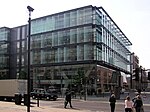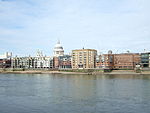Millennium Bridge, London

The Millennium Bridge, officially known as the London Millennium Footbridge, is a steel suspension bridge for pedestrians crossing the River Thames in London, England, linking Bankside with the City of London. It is owned and maintained by Bridge House Estates, a charitable trust overseen by the City of London Corporation. Construction began in 1998, and it initially opened on 10 June 2000. Londoners nicknamed it the "Wobbly Bridge" after pedestrians experienced an alarming swaying motion on its opening day. The bridge was closed later that day and, after two days of limited access, it was closed again for almost two years so that modifications and repairs could be made to keep the bridge stable and stop the swaying motion. It reopened in February 2002. The bridge is located between Southwark Bridge and Blackfriars Railway Bridge. Its southern end is near the Globe Theatre, the Bankside Gallery, and Tate Modern, while its northern end is next to the City of London School below St Paul's Cathedral. The bridge's alignment is such that a clear view (i.e. a "terminating vista") of St Paul's south façade is presented from across the river, framed by the bridge supports.
Excerpt from the Wikipedia article Millennium Bridge, London (License: CC BY-SA 3.0, Authors, Images).Millennium Bridge, London
Millennium Bridge, London Southwark (London Borough of Southwark)
Geographical coordinates (GPS) Address Nearby Places Show on map
Geographical coordinates (GPS)
| Latitude | Longitude |
|---|---|
| N 51.510173 ° | E -0.098438 ° |
Address
Millennium Bridge
Millennium Bridge
SE1 9JE London, Southwark (London Borough of Southwark)
England, United Kingdom
Open on Google Maps











